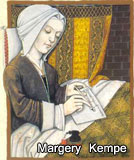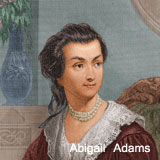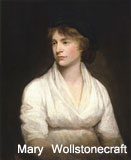For many years, women were almost invisible in literature. Women may have been writing, but if so, their names were not preserved. Centuries later, Virginia Woolf commented, "For most of history, 'Anonymous' was a woman." That's not a completely fair statement--for centuries, names of writers in general, whether men or women, were not listed. But it is a fact that up until the 1700s, very few women were writers.
There were a few, though. Julian of Norwich (1343?-1416) wrote a series of essays on her religious revelations. She was an anchorite nun who was unusually well-educated for the time: very few men learned to read and write during the Middle Ages, and even fewer women. Margery Kempe (1373?-1438?) composed her autobiography in the early 1400s, detailing her religious awakening and the social and political persecution she faced as a result of her compulsion to speak publicly about her beliefs in a time when women were expected to be silent and obedient and submissive to men. Her religious extremism doesn't sit well with many readers these days (it didn't sit well with her contemporaries, either!), but she shows tremendous courage in challenging not only her own husband but powerful politicians, judges, and church officials.
The Renaissance produced more women writers, primarily poets, among them Queen Elizabeth I herself. Elizabeth never married, but she wrote at least 6, and possibly as many as 16, love poems. Lady Mary Wroth, who served in Queen Elizabeth's court, was also a poet, known primarily for Pamphilia to Amphilanthus (1621), a collection of 83 love sonnets and 19 songs. There were a handful of other women poets as well, most of them from privileged families, all of them educated, unlike most of their peers. An exception was Aphra Behn, a penniless widow who served as a spy for the British government and later supported herself by writing plays for the London theater. She also wrote a few novels; the best-known of these is Oroonoko; or, The Royal Slave (1688). Anne Bradstreet was also a poet, but her life was vastly different from her English contemporaries: she was writing in the Massachussetts Bay Colony, where conditions were appallingly hard and illness was rampant. Nevertheless, her poems reveal her deep love for her husband and children, and even take the risk of defending women's right to write and be heard in a Puritan society where women had little power.
More women wrote during the 1700s than before, but still, the numbers are not high. The difference is that, along with the poets, essayists, and diarists, the first female fiction writers began to appear. Among them were the novelists Fanny Burney (Evelina, 1778; Cecilia, or Memoirs of an Heiress, 1782), Sarah Scott (A Description of Millenium Hall, 1762), and Ann Radcliff (The Mysteries of Udolpho, 1794; The Italian, 1797). Women still found it difficult to be taken seriously as writers, and they faced strong disapproval from the public and, often, their families. Fanny Burney's father and stepmother disapproved so strongly of her writing that, at the age of 15, she burned all of the work she had written until then.
One of the most important writers of the 18th century was Mary Wollstonecraft. She wrote a number of stories, novels, and essays, but her most famous and influential essay was A Vindication of the Rights of Woman (1792). In it, she makes a compelling argument that women should be educated just as men, and that, rather than being regarded as property, they should be seen as human beings with the same fundamental rights as men. Although the essay had very little concrete effect on social change in her time, it did influence subsequent generations of women and women writers.
By the 1800s, more women in England were writing, but many of them still faced resistance. Mary Anne Evans, for example,wrote under the pen name George Eliot to ensure that her works would be taken seriously. The Bronte sisters published their novels under men's names: Currer Bell for Charlotte, Ellis Bell for Emily, and Acton Bell for Anne. Some years earlier, Charlotte had sent her writing to England's Poet Laureate, Robert Southey, and the response he sent back to her read, in part,
Literature cannot be the business of a woman's life, and it ought not to be. The more she is engaged in her proper duties, the less leisure she will have for it, even as an accomplishment and a recreation. To those duties you have not yet been called, and when you are you will be less eager for celebrity...the daydreams in which you habitually indulge are likely to induce a distempered state of mind; and in proportion as all the ordinary uses of the world seem to you flat and unprofitable, you will be unfitted for them without becoming fitted for anything else.
Elizabeth Gaskell wrote under her own name, however, as did other women writers such as Mary Augusta Ward and Elizabeth Barrett Browning. In the United States, writers such as Harriet Beecher Stowe, Frances Hodgson Burnett, and Kate Chopin carved out careers for themselves.
By the 20th century, the numbers of women writers were much larger. And although writing was still primarily a men's profession (Dorothy Parker was, for example, the only regular female writer at the Algonquin Round Table), it was opening up more and more to women. Oddly, in the 1920s, there was virtually no discrimination against women in Hollywood, where the growth of the film industry was creating the need for more and more writers. Anita Loos was one of the most successful writers in the industry; Frances Marion was the highest paid screenwriter in Hollywood from 1916 until 1933; and many other women writers started their careers there at that time. When the Writers Guild was formed in 1940 and the salaries for screenwriting jobs rose, women began to find themselves left out in the cold more and more. This is pretty ironic, since many of the most powerful voices behind the formation of the union were women. Nevertheless, more and more women made a living as writers in the 20th century, and more and more barriers fell as the century progressed.
It seems an obvious thing to say, but not all women writers are alike. That is, no matter what the century or the environment, not all women writers share a single agenda. Some women write to make a political point--to argue, for example, for equal rights for women. Others write to shed light on religious or social issues. Still others write to tell a story. Some want to make the reader think deeply; others just want to tell entertaining stories and make a lot of money. Some write in essay form; others in memoir form; others in fictional or poetic forms.
In this class, we'll read a variety of writers with a variety of styles and goals. Our purpose here is not to rail against the discrimination women writers have faced across the centuries; nor is it to fight the battles of any particular political group. It is to do what we do with all literature: read it, enjoy it, analyze it, and think about how it mirrors or contrasts with our own reality. Azar Nafisi says that "what we search for in fiction is not so much reality as the epiphany of truth." We'll extend that to poetry, the essay and the memoir, as well as fiction, in this class.


